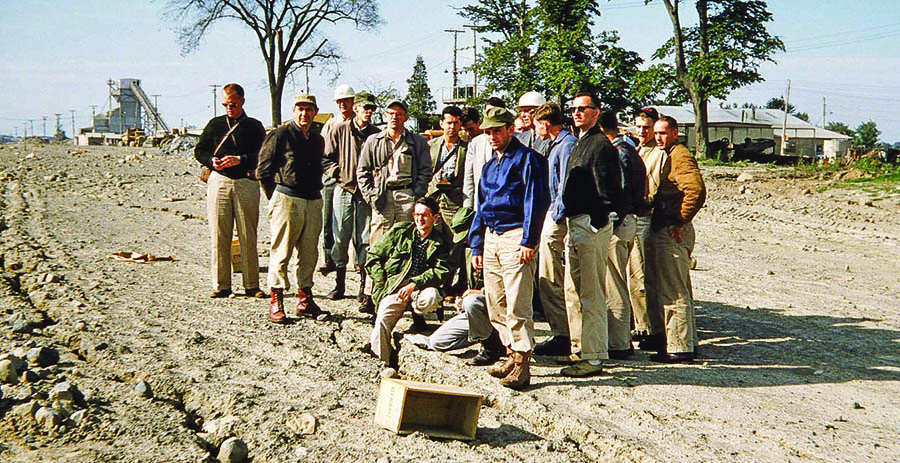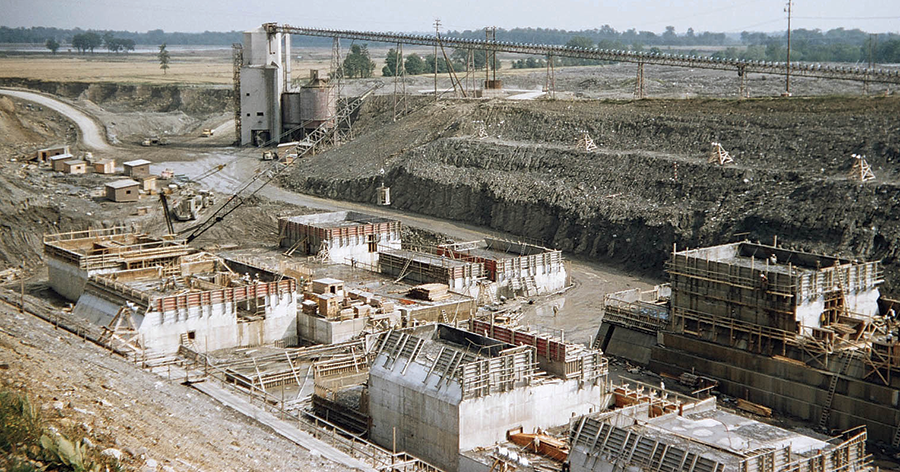
A Journey Worth Remembering: The 1956 St. Lawrence Seaway Construction Tour
Their senior courses at Carnegie Tech wouldn’t start for another week, but 19 members of the Civil Engineering class of 1957 had reunited early. Each one had brought a suitcase. They greeted each other, talking excitedly about the journey ahead, and, one after another, stacked their luggage in a growing pile in the covered back of a pickup truck.
Before long, the students were on the road and on their way to tour the St. Lawrence Seaway project, whose construction was at its peak that summer of 1956. The site visits had been planned by their Civil Engineering professor Elio D’Appolonia, and these seniors would be the first group—student or otherwise—to tour each of the project’s American and Canadian work sites.
When it came to the logistics of meals, hotels, and transportation, the students had been on their own but had successfully crafted a plan. As they set out from Pittsburgh, Russel Jones (BS ’57, MS ’60, PhD ’64) and his roommate, R. Stanton Over (BS ’57, MS ’63), led the caravan in the pickup that Jones had borrowed from his father.
Three cars followed them, including two with six people crammed inside. “Stan was the navigator; I was the driver,” recalls Jones. “We got lost only once.”
The St. Lawrence Seaway project was undoubtedly a sight worth seeing. With 22,000 workers involved, 6 million cubic yards of concrete poured, and over 210 million cubic yards of earth and rock moved from 1954 to 1959, the St. Lawrence Seaway is today counted among the top engineering feats of the 20th century.
On their trip, the students visited numerous locks, dams, and canals from Monday through Friday. They toured multiple sites every day and, rather than sticking to overlooks, got up close to the work in progress.
“In class, we had studied construction projects and Dr. D’Appolonia often brought in his own consulting projects and discussed them with us, but actually getting down there in the trenches during the construction of the locks and dams was an amazing experience,” recalls Jones.
At each stop, Dr. D’Appolonia arranged for top engineers to lead lectures and discussions on topics like concrete, soils and foundation engineering, geology, construction planning, and problems encountered. At the Moses-Saunders Power Dam, they even met with the dam’s namesake Robert Moses, who was overseeing its construction as head of the New York Power Authority.
“The locks we saw being built were massive, and we not only saw the construction underway, but met and talked with the designers and the people doing that construction,” Jones recalls. “It showed us what civil engineers actually do in the concrete, not the abstract.”
For Jones, the trip and Dr. D’Appolonia had a lasting impact. For starters, the experience helped secure his decision to stay in civil engineering rather than enter the aerospace field. Later, as a professor, Jones followed in the footsteps of Dr. D’Appolonia by sharing his own consulting projects with his students—something he says he benefited greatly from in Dr. D’Appolonia’s courses.
What’s more, the St. Lawrence Seaway trip was Jones’ first foray into travelling; he has since visited 108 countries and helped found several universities abroad. Jones’ roommate, Stan Over, was also inspired by Dr. D’Appolonia. He went on to lead a multi-disciplinary consulting firm of more than 200 engineers and technicians for over 20 years. He was responsible for, and was personally involved in, the design of more than 100 highway and bridge construction projects.
“I’ve made my alumni contribution to the Dr. Elio D’Appolonia Graduate Fund since it was set up in 2012—and I will continue to do so,” Jones says. “Dr. D’Appolonia was by far one of my favorite faculty members because he made what we were studying come alive.”
